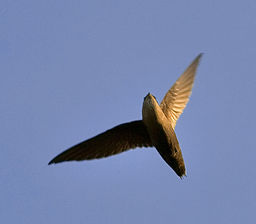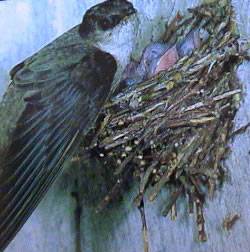As part of the Apodidae family, Chimney Swifts (Chaetura pelagica) are related to Hummingbirds.. They are very small birds, with an approximate length of 5” and wingspan of 11”. Males and females do not have a distinctly different appearance; both are a smudge-gray color. They are one of the most aerial birds, spending all of their time in flight with the exception of when roosting or on the nest. Swifts can consume 5,000 – 6,000 insects per day, making them very effective for controlling insects.
Although still relatively common, Chimney Swifts have been designated as Near Threatened since 2010. The most recent State of the Birds Report (2014, Nature Conservancy) lists Chimney Swifts as a Common Bird in Steep Decline. They have experienced a 70%+ decline over the last 50 years, with the rate of decline increasing in recent years. Their decline is attributed to a shift in chimney design, the capping and demolition of chimneys, and a decreased availability of their food source (insects) due to widespread use of pesticides.
Chimney Swifts are neo-tropical migrants which overwinter in the Amazon basin in South America. They begin to arrive in North America in late Spring and are common in the eastern portion of the United States and southeastern portion of Canada.
Chimney Swifts historically used limbs, snags, and caves for roosting and nesting but have adapted to use chimneys for these purposes. Swifts are common in cities, neighborhoods, and towns where there are chimneys present. They feed on insects and can be sighted foraging for insects in small groups (3 – 12). They forage individually during nesting.
Chimney roosts can be used by groups of birds that can reach numbers in the hundreds or even thousands. Using chimneys during migration allows swifts to conserve heat and avoid exposure.
Unmated swifts will continue to roost together during the breeding season. Keep an eye out before dusk between April – October to see groups of swifts entering roosting locations.
When nesting, Chimney Swifts will not allow other birds (including swifts) to use the tower or chimney where the nest is located. They defend their nesting structure during the breeding season. Parents share the responsibility of feeding the nestlings and can be seen entering and exiting the nesting site throughout the day.
Chimney Swifts are protected under the Migratory Bird Treaty Act. Disturbing birds, eggs, or nests that may contain eggs is illegal. If Chimney Swifts have moved into your chimney, there is no reason to worry. They will not cause any damage and will stay only temporarily.
Chimney Swifts are neo-tropical migrants. They typically arrive in Western Pennsylvania during the 3rd week of April and leave around the 1st week of October. Chimney Swifts typically migrate in large groups, ranging from 6 – 20 birds to thousands of birds.
There are a variety of ways that you can support Chimney Swift conservation. If you have a chimney, leave it uncapped and have it cleaned in March after the winter use but before Chimney Swifts arrive in our area. If your chimney has already been capped or your house doesn’t have a chimney, consider building a Chimney Swift tower. In order to help ensure that swifts have plenty of food, consider reducing or eliminating pesticide use. Another great option is to donate to ASWP to support our Chimney Swift conservation efforts.
Please email it to steward@aswp.org so it can be added to the map and monitoring program.
They eat insects – and a lot of them. They can eat up to 5,000 – 6,000 insects per day.
Both bats and Chimney Swifts are important parts of our environment and are beneficial to humans in a variety of ways such as eating insects. There are a number of ways to tell them apart. First, listen to the Chimney Swift call which is very distinctive and can be heard from a great distance. The sounds that bats make are undetectable by humans in the outdoors; there is a small chance that you will hear bat sounds when they are in an enclosed area. Another way to tell the difference is that Chimney Swifts fly at a much higher elevation than bats do. Bats become active in the evening whereas Chimney Swifts enter the roost at dusk to settle in for the night.
Listen to their calls by clicking here.
Please let us know if you know of a chimney that is being used for roosting or nesting that isn’t on our map, if you’d like more information on building your own Chimney Swift tower, or if you’d like to partner with us to further our Chimney Swift tower initiative. Contact us at info<@> aswp.org with your questions.
· Audubon Society – Guide to North American Birds. Chimney Swifts
· Cornell Lab of Ornithology – All About Birds, 2015. Chimney Swifts
· International Union for Conservation of Nature and Natural Resources, 2017. Chaetura pelagica

